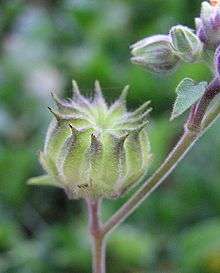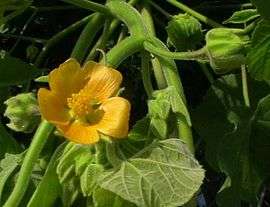Abutilon theophrasti
Abutilon theophrasti (velvetleaf, velvet plant, velvetweed, Chinese jute,[1] China jute, crown weed, buttonweed, lantern mallow, butterprint, pie-marker, or Indian mallow) is an annual plant in the family Malvaceae, native to southern Asia. Its specific epithet theophrasti commemorates the ancient Greek botanist-philosopher Theophrastus.[2] Abutilon theophrasti is the type species of the genus Abutilon.
| Abutilon theophrasti | |
|---|---|
 | |
| Abutilon theophrasti | |
| Scientific classification | |
| Kingdom: | Plantae |
| Clade: | Tracheophytes |
| Clade: | Angiosperms |
| Clade: | Eudicots |
| Clade: | Rosids |
| Order: | Malvales |
| Family: | Malvaceae |
| Genus: | Abutilon |
| Species: | A. theophrasti |
| Binomial name | |
| Abutilon theophrasti | |
Description
Velvetleaf grows 3–8 feet tall on branched stout stems. Their stems are covered in downy hairs. It annually grows in the warmer seasons. It germinates in the spring, and flowers in the summer. This typically takes place between the months of July to September in certain locations. The leaves are large and heart-shaped with point tips at their ends. They grow at different points along the length of the stem or are alternated along the stem, the leaves are attached to thick, long stems, and when crushed, they release an odor.[3]
It has flowers that are yellow; they grow up to an inch in diameter with five petals attached at the base. The flowers grow on stalked, and can either be found in clusters or singled along where the stalk meets the leaf stem.[3]
Pod-like capsules produced by the plant consists of 12-15 wood segments that form cup-like rings. Through the maturation of the seeds, the segments remain joined, and when the seed are ready to be released, the outside of the capsule contains vertical slits which release mature seeds.[3]
 Flower and leaves |
 Abutilon theophrasti - MHNT |
Schizocarp on a plant that grew in California. |
Biology
In reproduction of velvetleaf, the seeds can produce between 700 and 44,200 per one plant. The seeds take 17–22 days to mature once pollinated. Seeds can remain useful ~50 years when stored in a dry location or in the soil. In order to disperse the seeds for reproduction, each carpel in the plant is opened with a vertical slit along the outer edge. For successful germination of the seeds, the temperature must range between 24-30 °C. Due to the dry climate and high evaporation growth, Velvetleaf is unable to grow in the meadows of North America.[4] In order for Velvetleaf to grow, the soil ranges from gray-brown podzols and sandy to clay loams. Ideal soil pH for velvetleaf is between 6.1 and 7.8, depending on location.[5]
Cultivation and medicinal uses
Velvetleaf has been grown in China since around 2000 BCE for its strong, jute-like fibre. The leaves are edible stir-fried or in an omelette. The plant is known as maabulha in the Maldives and its leaves were part of the traditional Maldivian cuisine, usually finely chopped and mixed with Maldive fish and grated coconut in a dish known as mas huni.[6] The seeds are eaten in China and Kashmir.[7] To make ropes, coarse cloth, nets, paper and caulk for boats, Velvetleaf is still being cultivated to this day in China.[8] Velvetleaf can be used as a treatment for dysentery and opacity of the cornea and can treat eye injuries. The leaves of the velvet leaf contain 0.01% of rutin, and used for a soothing, lubricant treatment that softens irritated tissues. When the leaves are softened, they can be used a remedy for ulcers. The bark of Velvetleaf can reduce the flow of bodily fluids such as blood, secretions, mucous. It can promote the flow of urine.[9]
Invasive species
In midwestern and northeastern regions of the United States, eastern Canada and the Eastern Mediterranean, A. theophrasti is considered a damaging weed to agricultural crops, especially corn and soybeans.[10]
Since being introduced to North America in the 18th century, velvetleaf has become an invasive species in agricultural regions of the eastern and midwestern United States. It is one of the most detrimental weeds to corn causing decreases of up to 34% of crop yield if not controlled and costing hundreds of millions of dollars per year in control and damage. Velvetleaf is an extremely competitive plant, so much so that it can steal nutrients and water from crops.[11] Velvetleaf is controllable by herbicides even though it is known to be a major weed to different crops due to its harmful effects. Because of the season it germinates in, the plant matures right before the fall harvest in farms. Velvetleaf is a tall plant that can cause the crops around it to not thrive due to severely reducing light penetration to those surrounding crop plants. Not only does it affect crop plants by starving them of light, but it also houses different diseases and pests of crops like corn, cotton, soybeans, and others. When destroyed, the plant releases a chemical odor that is also known to be harmful to surrounding crops by inhibiting germination of crop seeds when that chemical is released into the soil.[3] Examples of pests that Velvetleaf harbors are maize pest, tobacco pest, and soybean diseases. In order to eradicate Velvetleaf, individuals should be dug up or pulled out manually and not tilled or plowed to avoid seed germination. For a more convenient mediation method, invasive individuals can be mowed while the plant is still small.[3]
This species is typically found in areas where the soil had been disturbed. This causes the dormant seeds in the soil to be brought closer to the soil's surface, allowing for growth when the soil is at an optimally warm temperature.[12]
Threats to A. theophrasti
Different predators and pathogens affect velvetleaf at different life stages of the plant. Examples of threats include but are not limited to:[4]
| Organism of Harm | Type of Threat | Effect on A. theophrasti |
| Verticillium dahliae | Wilt pathogen | Necrosis of leaves
Reduces seed production |
| Helicoverpa zea | Insect | Reduces seed production |
| Heliothis virescens | Insect | Reduces seed production |
| Liorhyssus hyalinus | Insect | Reduces seed production |
| Niesthrea louisianica | Insect | Reduces seed production |
| Althaeus folkertsi | Insect | Reduces seed production |
| Phomopsis longicolla | Pathogen | Red-brown lesions on lower stem and root area growing in soybean fields |
| Turnip mosaic virus | Pathogen | Causes severe mosaic symptoms |
References
- "velvetweed" in The Columbia-Viking Desk Encyclopedia (1953), New York: Viking.
- De Ruff, Robert. "A short description of Abutilon theophrasti". Plants of Upper Newport Bay.
- "Velvetleaf Identification and Control Abutilon theophrasti". KingCounty. September 18, 2018.
- "Abutilon theophrasti (velvet leaf)". www.cabi.org. Retrieved 2019-02-11.
- "Canadian Science Publishing". doi:10.4141/cjps88-127. Cite journal requires
|journal=(help) - Xavier Romero-Frias, The Maldive Islanders, A Study of the Popular Culture of an Ancient Ocean Kingdom, Barcelona 1999, ISBN 84-7254-801-5
- "Velvetleaf". Written Findings of the State Noxious Weed Control Board - Class A Weed. February 2000. Archived from the original on 2006-06-16.
- Steckel, Larry (July 2007). "Velvetleaf" (PDF). The University of Tennessee.
- "Abutilon theophrasti China Jute, Velvetleaf, Butterprint Buttonweed Jute, China Mallow, Indian Velvet Leaf PFAF Plant Database". pfaf.org. Retrieved 2019-02-11.
- Hameed A. Baloch, Antonio DiTommaso and Alan K. Watson. "Intrapopulation variation in Abutilon theophrasti seed mass and its relationship to seed germinability" (PDF). Seed Science Research (2001) 11, 335–343. Archived from the original (PDF) on 2010-06-28.
- Davis, K. Renner, C. Sprague, L. Dyer, D. Mutch (2005). Integrated Weed Management. MSU
- "Velvetleaf, Abutilon theophrasti". Master Gardener Program. Retrieved 2019-02-11.
External links

- Abutilon theophrasti from Plants for a Future